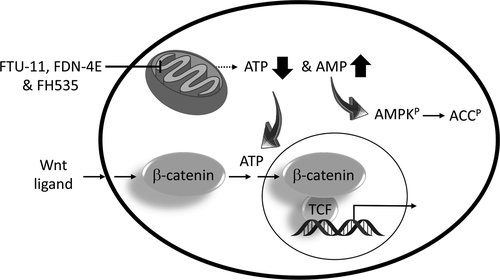当前位置:
X-MOL 学术
›
J. Med. Chem.
›
论文详情
Our official English website, www.x-mol.net, welcomes your
feedback! (Note: you will need to create a separate account there.)
An Underlying Mechanism of Dual Wnt Inhibition and AMPK Activation: Mitochondrial Uncouplers Masquerading as Wnt Inhibitors.
Journal of Medicinal Chemistry ( IF 6.8 ) Pub Date : 2019-12-16 , DOI: 10.1021/acs.jmedchem.9b01685 Wen Zhang , Vitaliy M Sviripa , Liliia M Kril , Tianxin Yu , Yanqi Xie , W Brad Hubbard , Patrick G Sullivan , Xi Chen , Chang-Guo Zhan , Yang Yang-Hartwich 1 , B Mark Evers , Brett T Spear , Roberto Gedaly , David S Watt , Chunming Liu
Journal of Medicinal Chemistry ( IF 6.8 ) Pub Date : 2019-12-16 , DOI: 10.1021/acs.jmedchem.9b01685 Wen Zhang , Vitaliy M Sviripa , Liliia M Kril , Tianxin Yu , Yanqi Xie , W Brad Hubbard , Patrick G Sullivan , Xi Chen , Chang-Guo Zhan , Yang Yang-Hartwich 1 , B Mark Evers , Brett T Spear , Roberto Gedaly , David S Watt , Chunming Liu
Affiliation

|
The importance of upregulated Wnt signaling in colorectal cancers led to efforts to develop inhibitors that target β-catenin in this pathway. We now report that several "Wnt inhibitors" that allegedly target β-catenin actually function as mitochondrial proton uncouplers that independently activate AMPK and concomitantly inhibit Wnt signaling. As expected for a process in which mitochondrial uncoupling diminishes ATP production, a mitochondrial proton uncoupler, FCCP, and a glucose metabolic inhibitor, 2-DG, activated AMPK and inhibited Wnt signaling. Also consistent with these findings, a well-known "Wnt inhibitor", FH535, functioned as a proton uncoupler, and in support of this finding, the N-methylated analog, 2,5-dichloro-N-methyl-N-(2-methyl-4-nitrophenyl)benzenesulfonamide (FH535-M), was inactive as an uncoupler and Wnt inhibitor. Apart from suggesting an opportunity to develop dual Wnt inhibitors and AMPK activators, these findings provide a cautionary tale that claims for Wnt inhibition alone require scrutiny as possible mitochondrial proton uncouplers or inhibitors of the electron transport chain.
中文翻译:

Wnt 双重抑制和 AMPK 激活的潜在机制:伪装成 Wnt 抑制剂的线粒体解偶联剂。
Wnt 信号上调在结直肠癌中的重要性促使人们努力开发针对该通路中 β-catenin 的抑制剂。我们现在报道了几种据称针对 β-连环蛋白的“Wnt 抑制剂”实际上充当线粒体质子解偶联剂,独立激活 AMPK 并同时抑制 Wnt 信号传导。正如线粒体解偶联减少 ATP 产生的过程所预期的那样,线粒体质子解偶联剂 FCCP 和葡萄糖代谢抑制剂 2-DG 激活 AMPK 并抑制 Wnt 信号传导。同样与这些发现一致的是,一种著名的“Wnt 抑制剂”FH535 充当质子解偶联剂,并且支持这一发现的 N-甲基化类似物 2,5-二氯-N-甲基-N-(2 -甲基-4-硝基苯基)苯磺酰胺 (FH535-M) 作为解偶联剂和 Wnt 抑制剂没有活性。除了提出开发双重 Wnt 抑制剂和 AMPK 激活剂的机会外,这些发现还提供了一个警示,即单独抑制 Wnt 的主张需要仔细审查,因为可能是线粒体质子解偶联剂或电子传递链抑制剂。
更新日期:2019-12-17
中文翻译:

Wnt 双重抑制和 AMPK 激活的潜在机制:伪装成 Wnt 抑制剂的线粒体解偶联剂。
Wnt 信号上调在结直肠癌中的重要性促使人们努力开发针对该通路中 β-catenin 的抑制剂。我们现在报道了几种据称针对 β-连环蛋白的“Wnt 抑制剂”实际上充当线粒体质子解偶联剂,独立激活 AMPK 并同时抑制 Wnt 信号传导。正如线粒体解偶联减少 ATP 产生的过程所预期的那样,线粒体质子解偶联剂 FCCP 和葡萄糖代谢抑制剂 2-DG 激活 AMPK 并抑制 Wnt 信号传导。同样与这些发现一致的是,一种著名的“Wnt 抑制剂”FH535 充当质子解偶联剂,并且支持这一发现的 N-甲基化类似物 2,5-二氯-N-甲基-N-(2 -甲基-4-硝基苯基)苯磺酰胺 (FH535-M) 作为解偶联剂和 Wnt 抑制剂没有活性。除了提出开发双重 Wnt 抑制剂和 AMPK 激活剂的机会外,这些发现还提供了一个警示,即单独抑制 Wnt 的主张需要仔细审查,因为可能是线粒体质子解偶联剂或电子传递链抑制剂。













































 京公网安备 11010802027423号
京公网安备 11010802027423号